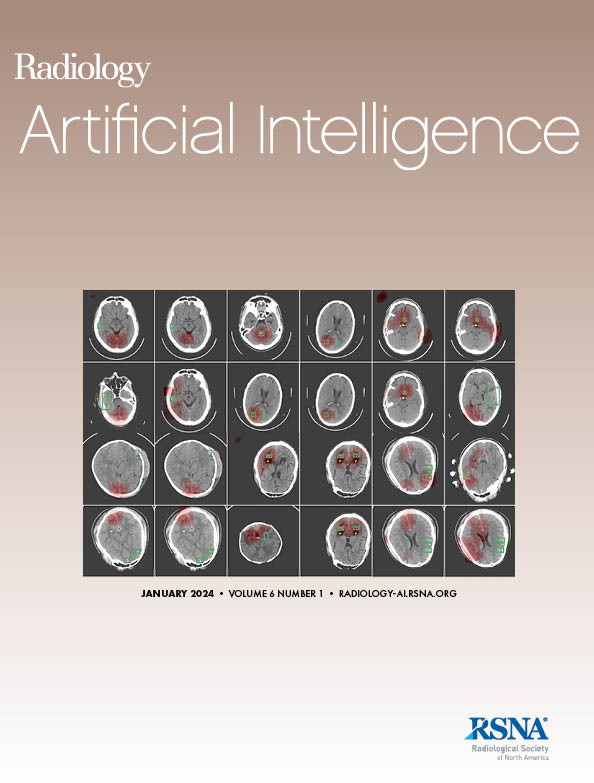Batuhan Gundogdu, Aritrick Chatterjee, Milica Medved, Ulas Bagci, Gregory S Karczmar, Aytekin Oto
下载PDF
{"title":"混合多维MRI前列腺组织微观结构分析的物理信息自编码器。","authors":"Batuhan Gundogdu, Aritrick Chatterjee, Milica Medved, Ulas Bagci, Gregory S Karczmar, Aytekin Oto","doi":"10.1148/ryai.240167","DOIUrl":null,"url":null,"abstract":"<p><p>Purpose To evaluate the performance of Physics-Informed Autoencoder (PIA), a self-supervised deep learning model, in measuring tissue-based biomarkers for prostate cancer (PCa) using hybrid multidimensional MRI. Materials and Methods This retrospective study introduces PIA, an emerging self-supervised deep learning model that integrates a three-compartment diffusion-relaxation model with hybrid multidimensional MRI. PIA was trained to encode the biophysical model into a deep neural network to predict measurements of tissue-specific biomarkers for PCa without extensive training data requirements. Comprehensive in silico and in vivo experiments, using histopathology measurements as the reference standard, were conducted to validate the model's efficacy in comparison to the traditional nonlinear least squares (NLLS) algorithm. PIA's robustness to noise was tested in in silico experiments with varying signal-to-noise ratio (SNR) conditions, and in vivo performance for estimating volume fractions was evaluated in 21 patients (mean age, 60 years ± 6.6 [SD]; all male) with PCa (71 regions of interest). Evaluation metrics included the intraclass correlation coefficient (ICC) and Pearson correlation coefficient. Results PIA predicted the reference standard tissue parameters with high accuracy, outperforming conventional NLLS methods, especially under noisy conditions (<i>r</i><sub>s</sub> = 0.80 vs 0.65, <i>P</i> < .001 for epithelium volume at SNR of 20:1). In in vivo validation, PIA's noninvasive volume fraction estimates matched quantitative histology (ICC, 0.94, 0.85, and 0.92 for epithelium, stroma, and lumen compartments, respectively; <i>P</i> < .001 for all). PIA's measurements strongly correlated with PCa aggressiveness (<i>r</i> = 0.75, <i>P</i> < .001). Furthermore, PIA ran 10 000 faster than NLLS (0.18 second vs 40 minutes per image). Conclusion PIA provided accurate prostate tissue biomarker measurements from MRI data with better robustness to noise and computational efficiency compared with the NLLS algorithm. The results demonstrate the potential of PIA as an accurate, noninvasive, and explainable artificial intelligence method for PCa detection. <b>Keywords:</b> Prostate, Stacked Auto-Encoders, Tissue Characterization, MR-Diffusion-weighted Imaging <i>Supplemental material is available for this article.</i> ©RSNA, 2025 See also commentary by Adams and Bressem in this issue.</p>","PeriodicalId":29787,"journal":{"name":"Radiology-Artificial Intelligence","volume":" ","pages":"e240167"},"PeriodicalIF":13.2000,"publicationDate":"2025-03-01","publicationTypes":"Journal Article","fieldsOfStudy":null,"isOpenAccess":false,"openAccessPdf":"https://www.ncbi.nlm.nih.gov/pmc/articles/PMC11950878/pdf/","citationCount":"0","resultStr":"{\"title\":\"Physics-Informed Autoencoder for Prostate Tissue Microstructure Profiling with Hybrid Multidimensional MRI.\",\"authors\":\"Batuhan Gundogdu, Aritrick Chatterjee, Milica Medved, Ulas Bagci, Gregory S Karczmar, Aytekin Oto\",\"doi\":\"10.1148/ryai.240167\",\"DOIUrl\":null,\"url\":null,\"abstract\":\"<p><p>Purpose To evaluate the performance of Physics-Informed Autoencoder (PIA), a self-supervised deep learning model, in measuring tissue-based biomarkers for prostate cancer (PCa) using hybrid multidimensional MRI. Materials and Methods This retrospective study introduces PIA, an emerging self-supervised deep learning model that integrates a three-compartment diffusion-relaxation model with hybrid multidimensional MRI. PIA was trained to encode the biophysical model into a deep neural network to predict measurements of tissue-specific biomarkers for PCa without extensive training data requirements. Comprehensive in silico and in vivo experiments, using histopathology measurements as the reference standard, were conducted to validate the model's efficacy in comparison to the traditional nonlinear least squares (NLLS) algorithm. PIA's robustness to noise was tested in in silico experiments with varying signal-to-noise ratio (SNR) conditions, and in vivo performance for estimating volume fractions was evaluated in 21 patients (mean age, 60 years ± 6.6 [SD]; all male) with PCa (71 regions of interest). Evaluation metrics included the intraclass correlation coefficient (ICC) and Pearson correlation coefficient. Results PIA predicted the reference standard tissue parameters with high accuracy, outperforming conventional NLLS methods, especially under noisy conditions (<i>r</i><sub>s</sub> = 0.80 vs 0.65, <i>P</i> < .001 for epithelium volume at SNR of 20:1). In in vivo validation, PIA's noninvasive volume fraction estimates matched quantitative histology (ICC, 0.94, 0.85, and 0.92 for epithelium, stroma, and lumen compartments, respectively; <i>P</i> < .001 for all). PIA's measurements strongly correlated with PCa aggressiveness (<i>r</i> = 0.75, <i>P</i> < .001). Furthermore, PIA ran 10 000 faster than NLLS (0.18 second vs 40 minutes per image). Conclusion PIA provided accurate prostate tissue biomarker measurements from MRI data with better robustness to noise and computational efficiency compared with the NLLS algorithm. The results demonstrate the potential of PIA as an accurate, noninvasive, and explainable artificial intelligence method for PCa detection. <b>Keywords:</b> Prostate, Stacked Auto-Encoders, Tissue Characterization, MR-Diffusion-weighted Imaging <i>Supplemental material is available for this article.</i> ©RSNA, 2025 See also commentary by Adams and Bressem in this issue.</p>\",\"PeriodicalId\":29787,\"journal\":{\"name\":\"Radiology-Artificial Intelligence\",\"volume\":\" \",\"pages\":\"e240167\"},\"PeriodicalIF\":13.2000,\"publicationDate\":\"2025-03-01\",\"publicationTypes\":\"Journal Article\",\"fieldsOfStudy\":null,\"isOpenAccess\":false,\"openAccessPdf\":\"https://www.ncbi.nlm.nih.gov/pmc/articles/PMC11950878/pdf/\",\"citationCount\":\"0\",\"resultStr\":null,\"platform\":\"Semanticscholar\",\"paperid\":null,\"PeriodicalName\":\"Radiology-Artificial Intelligence\",\"FirstCategoryId\":\"1085\",\"ListUrlMain\":\"https://doi.org/10.1148/ryai.240167\",\"RegionNum\":0,\"RegionCategory\":null,\"ArticlePicture\":[],\"TitleCN\":null,\"AbstractTextCN\":null,\"PMCID\":null,\"EPubDate\":\"\",\"PubModel\":\"\",\"JCR\":\"Q1\",\"JCRName\":\"COMPUTER SCIENCE, ARTIFICIAL INTELLIGENCE\",\"Score\":null,\"Total\":0}","platform":"Semanticscholar","paperid":null,"PeriodicalName":"Radiology-Artificial Intelligence","FirstCategoryId":"1085","ListUrlMain":"https://doi.org/10.1148/ryai.240167","RegionNum":0,"RegionCategory":null,"ArticlePicture":[],"TitleCN":null,"AbstractTextCN":null,"PMCID":null,"EPubDate":"","PubModel":"","JCR":"Q1","JCRName":"COMPUTER SCIENCE, ARTIFICIAL INTELLIGENCE","Score":null,"Total":0}
引用次数: 0
引用
批量引用

 求助内容:
求助内容: 应助结果提醒方式:
应助结果提醒方式:


